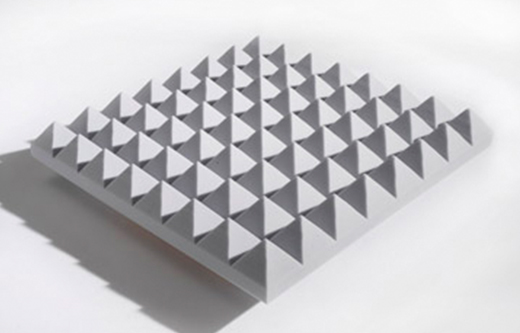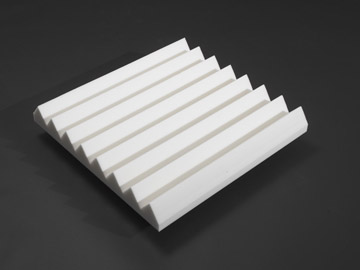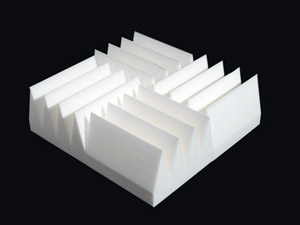Soundproofing Foam
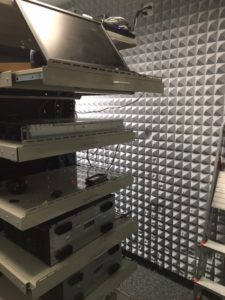 All acoustic foam panels supplied by NetWell Noise Control are class A fire rated and approved for use in any public or private setting. We offer a variety of soundproof foam panel options, including three different colors of Melamine Foam. A favorite among DIY enthusiasts, our acoustic foam panels are easy to install with silicone adhesive.
All acoustic foam panels supplied by NetWell Noise Control are class A fire rated and approved for use in any public or private setting. We offer a variety of soundproof foam panel options, including three different colors of Melamine Foam. A favorite among DIY enthusiasts, our acoustic foam panels are easy to install with silicone adhesive.
Our soundproof foam panels are used in acoustic applications such as recording studios, music rooms, vocal booths, broadcast studios, as well as, in soundproof foam applications in commercial and industrial settings.
Does Acoustic Foam Block Noise?
Foam panels are designed to absorb echoes inside a room, and not block noise from bleeding into or out of the room. Use soundproofing foam panels to control ambient noise levels within the room, and not combat noise bleeding to adjoining spaces. Think of the foam panel as a sponge, and not a brick. Use it to soak up energy within your room. By collapsing back on the level of echo, you generate greater clarity to original sound.
What are Soundproofing Foam Panels Made Out Of?
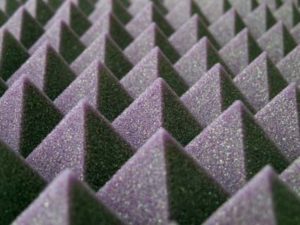 Acoustic foam panels are generally cut with a hot wire saw from a larger bun of original foam. The foam is typically a 2# density, light weight, made from either melamine foam or polyurethane foam. The foam has to be “open” cell for it to work. As compared to “closed” cell foam such as styrofoam. Do not use styrofoam to absorb echoes, the pores of the foam are closed and unable to convert the energy. Always be conscious of the fire rating of the foam panel you select. NetWell Noise Control offers only the melamine foam, such as our Pyramids, because it is class A fire rated and safe for use in any commercial, industrial or residential venue. Whereas Polyurethane foam is class B fire rated, not class A.
Acoustic foam panels are generally cut with a hot wire saw from a larger bun of original foam. The foam is typically a 2# density, light weight, made from either melamine foam or polyurethane foam. The foam has to be “open” cell for it to work. As compared to “closed” cell foam such as styrofoam. Do not use styrofoam to absorb echoes, the pores of the foam are closed and unable to convert the energy. Always be conscious of the fire rating of the foam panel you select. NetWell Noise Control offers only the melamine foam, such as our Pyramids, because it is class A fire rated and safe for use in any commercial, industrial or residential venue. Whereas Polyurethane foam is class B fire rated, not class A.
Is Acoustic Foam better than Fiberglass Panels?
Not necessarily, but there are differences. Soundproofing foam is more brittle, and will have a shelf life to it, while fiberglass panels, such as the Fabric Panels, are more durable and will not decay over time like acoustic foam will. Acoustic foam is made from chemicals. The pores of the foam, which are doing the conversion work to reduce sound wave reflections in a room, will eventually decay and stop working as well. The foam will begin to crumble. The shelf life might last 10 years, but it will decay. Fiberglass panels will not. Also note that foam is less durable to the touch. This makes acoustic foam panels ideal for recording studios, radio stations, drum booths, and sound testing anechoic chambers, but not ideal for soundproofing rooms in schools, church, restaurants, office space and so on. For help in selecting the correct sound panel for your project, call the help desk at NetWell Noise Control.
1-800-638-9355
Are Sound Foam Panels Class A Fire Rated?
This depends on what the raw material is made out of. If the foam panels are cut from Polyurethane Foam, then no. The panels will be Class B fire rated, meeting a fire code called the UL94 HF-1 test procedure. But if the panels are cut from Melamine Foam, then yes! Melamine Foam is Class A fire rated, meeting the fire code called the ASTM e84 test procedure. NetWell Noise Control recommends Melamine Acoustic Foam Panels for all of its soundproofing foam clients.
How Does Acoustic Foam Work?
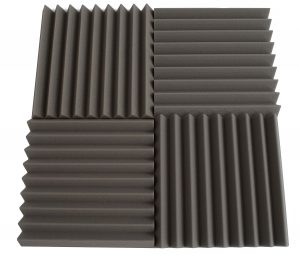 The pores of the foam accept sound wave vibrations. The pores fill with the energy and begin to vibrate. The vibrations produce a low grade form of heat, called Kinetic Energy. The conversion from sound wave energy to kinetic energy, means that a lower portion of the original sound wave is able to bounce into and then back out of the foam panel. With less sound wave reflection in the room, there is less echo, and greater clarity to original sound. This is how a sound panel will soundproof a room.
The pores of the foam accept sound wave vibrations. The pores fill with the energy and begin to vibrate. The vibrations produce a low grade form of heat, called Kinetic Energy. The conversion from sound wave energy to kinetic energy, means that a lower portion of the original sound wave is able to bounce into and then back out of the foam panel. With less sound wave reflection in the room, there is less echo, and greater clarity to original sound. This is how a sound panel will soundproof a room.
Does panel thickness matter?
Yes. The thicker you go with your choice in acoustic foam panels, the greater your rate of absorption. Also note, the thicker foam panels will generate greater sound values back for low frequency based sound waves, than thinner panels. Lower frequency noise has longer, flatter sound waves which can make their way into and back out of a thinner acoustic foam panel than a thicker acoustic foam panel. For low bass frequency noise, and for impact noise, always opt for thicker panels. Again, call the help desk at NetWell Noise Control to assist in your selection.
1-800-683-9355
How many acoustic foam panels do I need?
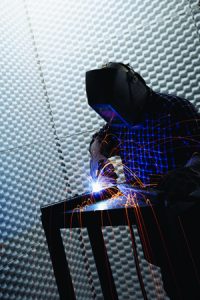 The answer depends on the frequency of the noise, the size of the room, and the intended results you are attempting to trigger. If you are a live room in a recording studio, for example, cover the equivalent to 50% of your overall wall space. Space and place the panels as you wish, but introduce this level of acoustic foam into your room. If you are a drummer with a booth, cover 70% of the walls and go thicker with the panels, target a 3″ thick depth. If you are sound testing engines for rattle in an anechoic chamber, then cover 100% of the surfaces in the test chamber and go 6-8″ thick or more. And if you are a podcast studio, scale back to 30% coverage with 2″ thick panels. You see there’s quite a variance in combinations of coverage and thickness, so again, contact your sound consultant at NetWell for advice.
The answer depends on the frequency of the noise, the size of the room, and the intended results you are attempting to trigger. If you are a live room in a recording studio, for example, cover the equivalent to 50% of your overall wall space. Space and place the panels as you wish, but introduce this level of acoustic foam into your room. If you are a drummer with a booth, cover 70% of the walls and go thicker with the panels, target a 3″ thick depth. If you are sound testing engines for rattle in an anechoic chamber, then cover 100% of the surfaces in the test chamber and go 6-8″ thick or more. And if you are a podcast studio, scale back to 30% coverage with 2″ thick panels. You see there’s quite a variance in combinations of coverage and thickness, so again, contact your sound consultant at NetWell for advice.
What is an NRC Value for Soundproofing Foam?
The NRC Value stands for Noise Reduction Coefficient. It is a measuring tool that indicates the performance value of your acoustic foam panel. The higher the number the better. The thicker the panel, the stronger the number. The lower the frequency of noise, the weaker the number gets. Essentially it is equal to the percentage of echoes pulled from the room. The correct definition however is that it is a measure of the number of Sabins each individual square foot of foam panel is adding into the room.
How to Custom Trim Acoustic Foam Panels
A utility knife or box cutter can easily slice through the backside of any acoustic foam panel.
Why do Acoustic Foam Panels Have Sculpted Fronts?
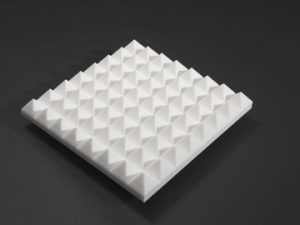 Pyramids. 2’x2′ squares with a continuous Pyramid design. The most popular cut of acoustic foam as it leaves one continuous view of the Pyramid bevel across the expanse of the full wall or ceiling surface it applies to.
Pyramids. 2’x2′ squares with a continuous Pyramid design. The most popular cut of acoustic foam as it leaves one continuous view of the Pyramid bevel across the expanse of the full wall or ceiling surface it applies to.
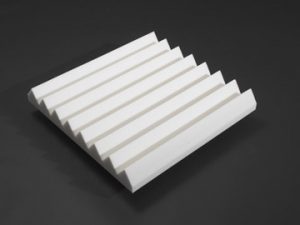 VCuts. 2’x2′ squares that generate a “parquet” look on your wall or ceiling surface. The idea is to rotate each square 90 degrees so each panel remains perpendicular to its neighboring panel.
VCuts. 2’x2′ squares that generate a “parquet” look on your wall or ceiling surface. The idea is to rotate each square 90 degrees so each panel remains perpendicular to its neighboring panel.
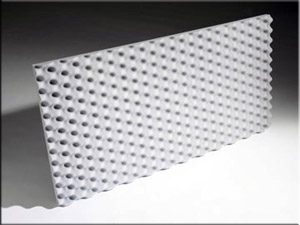 FireFlex. 2’x4′ panels of acoustic foam that generate the familiar “egg crate” design. Note the continuity form panel to panel will not align, so not as popular for cosmetic applications, and more popular for industrial noise control projects.
FireFlex. 2’x4′ panels of acoustic foam that generate the familiar “egg crate” design. Note the continuity form panel to panel will not align, so not as popular for cosmetic applications, and more popular for industrial noise control projects.
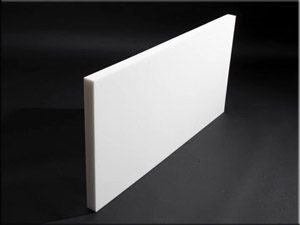 MelaFlats. 2’x4′ panels of 1″ thick flat foam. Thin flat foam is typically not recommended for improving interior room acoustics as it is too thin. Most clients here are OEM customers who need foam for quieting machine noise.
MelaFlats. 2’x4′ panels of 1″ thick flat foam. Thin flat foam is typically not recommended for improving interior room acoustics as it is too thin. Most clients here are OEM customers who need foam for quieting machine noise.
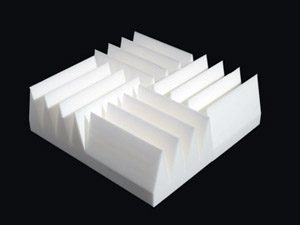 MelaMax. 12″ x 12″ cubes of foam that are cut 6″-8″ thick for premium anechoic capture in sound testing booths. Rotate each panel 90 degrees to create the parquet look.
MelaMax. 12″ x 12″ cubes of foam that are cut 6″-8″ thick for premium anechoic capture in sound testing booths. Rotate each panel 90 degrees to create the parquet look.
How Much do Acoustic Foam Panels Weigh?
Acoustic foam panels are light weight. A 2’x2′ Pyramid foam panel will weigh 2 pounds. Any foam panel that is dense will not absorb echoes and soundproof your space. You need light weight panels.
Where Can I Buy Acoustic Foam Panels?
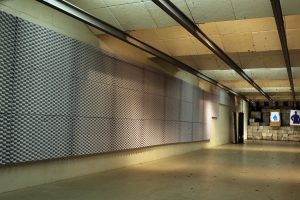 Acoustic foam panels are available online from a variety of sources. Care must be given when ordering your soundproofing foam panels to getting the panel thickness and coverage amounts correct, and then also ensuring you are meeting class A fire codes with your choice. Again, call NetWell Noise Control’s help desk to aid in your selection process.
Acoustic foam panels are available online from a variety of sources. Care must be given when ordering your soundproofing foam panels to getting the panel thickness and coverage amounts correct, and then also ensuring you are meeting class A fire codes with your choice. Again, call NetWell Noise Control’s help desk to aid in your selection process.
1-800-638-9355
What Colors Do Acoustic Foam Panels Come In?
If your choice is with Melamine Foam due to its Class A fire rating, then the color options are White, Light Gray or Dark Gray. If you see acoustic foams on the market that are blue, red, green, yellow, or a host of other colors, chances are good the raw material is not Class A fire rated and should not be used in public venues.
How is Acoustic Foam installed?
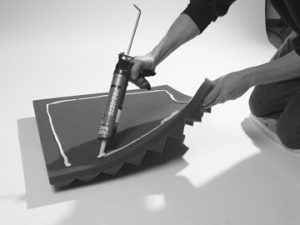 A caulking gun and silicone adhesive is all you need to install your sound panel system. Any silicone based adhesive works just fine.
A caulking gun and silicone adhesive is all you need to install your sound panel system. Any silicone based adhesive works just fine.
How to Choose Your Acoustic Foam Panels
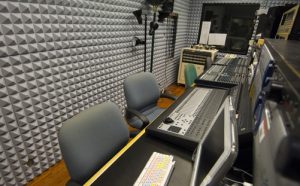 The key to getting your desired sound is in choosing the correct acoustic foam panel thickness and the right number of soundproofing panels for your project. Thicker foam acoustic panels will generate stronger sound absorption values at the low frequency end of the sound spectrum. The thicker your soundproof foam panels (for example our Anechoic Foam Panels, MelaMax), the better they will perform for low bass noise stemming from musical instruments or industrial machinery. If you are wanting to control mid to high range frequencies, such as human voice, you should choose one of our thinner soundproof foam panels.
The key to getting your desired sound is in choosing the correct acoustic foam panel thickness and the right number of soundproofing panels for your project. Thicker foam acoustic panels will generate stronger sound absorption values at the low frequency end of the sound spectrum. The thicker your soundproof foam panels (for example our Anechoic Foam Panels, MelaMax), the better they will perform for low bass noise stemming from musical instruments or industrial machinery. If you are wanting to control mid to high range frequencies, such as human voice, you should choose one of our thinner soundproof foam panels.
Coverage amounts depend on the size and scope of your soundproofing project. Check with our help desk to insure proper treatment of your space. By explaining your acoustic application, we can properly guide you in the quantity of acoustic foam panels needed.
To insure proper coverage and panel thickness for your soundproofing project, we recommend consulting with our help desk.
Alternative Acoustic Foam Products
Because soundproof foam and foam acoustic panels are chemically based, they will decompose over time and become brittle. Be sure to ask about alternative acoustic products that best meet the environmental needs of your project. We offer several alternatives to acoustic foam. We can help you find the perfect fit based on your specific soundproofing and noise control needs.
For additional help in selecting the right product, call our help desk at 1-800-638-9355.
Pyramid Foam Acoustic Panels
Pyramid foam acoustic panels absorb echoes and create premium sound quality. They are cut into 2’x2′ squares that measure 2″, 3″ or 4″ thick thickness. Ideal for combating sound wave reflections in a variety of commercial or industrial applications. Note that as you place the Pyramid soundproof foam panels flush to your surface, that the alignment from panel to panel will generate a continuous look to your treatment, stretching seamlessly across the expanse of your surface. If your acoustic treatment is targeting human voice only, opt for the 2″ thickness. But if your acoustic treatment is targeting control over bass reverberations stemming from musical instruments or industrial machinery, target the 3″ or 4″ thick acoustic Pyramid soundproof foam panels. Call our help desk as needed. 1-800-638-9355.
VCut Soundproof Foam Wedges
The VCut sculpt from our melamine foam will combine to produce the decorative parquet look to your perimeter wall surface. These VCut foam wedges produce a striking presentation to your room using sound dampening foam to control excessive levels of background noise. Unlike the Pyramids which generate a continuous and seamless look to the surface being treated, the VCuts are designed to generate the unique parquet look. Both products perform to the same values back, they simply represent two different visual presentations of the same acoustic foam for your project. Again, thicker VCut soundproof foam panels should be targeted if your sound sources are low bass frequencies such as drums, bass guitars, or industrial machines. Thinner foam acoustic panels will suffice if the noise source is mid to high range such as you will find in human voice. Call our help desk to help diagnose the correct panel thickness and count for your upcoming acoustic project. 1-800-638-9355.
MelaMax Soundproof Foam
MelaMax are ultra thick blocks of melamine acoustic foam to tackle the most aggressive sound sources and are also the product of choice for all anechoic chambers and dynamometer rooms. Use these MelaMax anechoic foam panels only for your most aggressive noise sources or for sound test measuring. These cubes of thick acoustic foam measure 12″x 12″ square, and are typically shipped in 6″ or 8″ thickness. But they can also be cut up to 36″ in depth using the same melamine foam.
FireFlex Acoustic Foam Panels
FireFlex melamine acoustic foam panels are ideal in a variety of settings from recording studios to factories. Soundproof panels are available in three color and thickness options, allowing you to choose the base frequency energy level you need.
